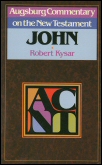Augsburg Commentary on the New Testament | ACNT (15 vols.)
Digital Logos Edition
Overview
The 15-volume Augsburg Commentary on the New Testament brings the best of biblical scholarship to bear on the most pressing exegetical and interpretive issues in the New Testament. These volumes explain the text of the New Testament section by section, and probe the basic questions of the entire New Testament for students, scholars, pastors, and laypersons. The authors contribute both as experts in their field and as individuals devoted to the life of the church. This commentary attests to their belief that central to the faith and life of the church of God is the Word of God.
Each volume in the Augsburg Commentary on the New Testament contains an introduction and topical overview of each book of the New Testament, along with an account of that book’s influence in church history, such as the impact of Romans on Augustine, Wesley, and Barth, and Martin Luther’s appraisal of James. The authors also discuss textual issues, historical topics such as authorship and dating, as well as literary conventions and exegetical and interpretive challenges. Each commentary concludes with a bibliography of other books, articles, and reference works to consult for further study.
The Augsburg Commentary on the New Testament serves as a sermon aid to preachers, as a vital reference tool for students and scholars, and as an ideal resource for personal or group Bible study.

- Comprehensive introduction to each book of the New Testament
- Discussions of historical issues, such as authorship, dating, and location
- Textual and literary notes
- Detailed outlines of every book in the New Testament
- Bibliographies and suggestions for further reading and study
- Scripture references linked to your Greek New Testament or English translation
- Title: Augsburg Commentary on the New Testament
- Editors: Roy A. Harrisville, Jack Dean Kingsbury, and Gerhard A. Krodel
- Publisher: Augsburg
- Volumes: 15
- Pages: 4,295
- Format: Logos Research Edition
- Resource ID: {0AF447C8-52DF-4722-AF7C-CCE98B146F3D}
This title is included in the following collections
You can save when you purchase this product as part of a collection.
2025 Lutheran Silver
$349.99$279.992025 Lutheran Gold
$849.99$679.992025 Lutheran Platinum
$1,499.99$1,199.992025 Lutheran Diamond
$2,999.99$2,249.99
- $2,999.99
- $4,749.99$3,562.49
- $4,749.99
- $4,749.99
- $10,999.99$8,249.99
- $23,999.99$17,999.99
- $21,749.99
- $24,999.99
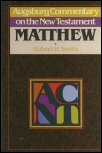
Matthew’s Gospel has been cherished as “the ecclesiastical Gospel” and as “the teaching Gospel.” The only use of the word church in the four Gospels, for example, is found in Matthew, and the rhythm of the Lord’s Prayer and the organization of Jesus’ words in discourses evokes liturgical imagery. Matthew’s Gospel certainly is a treasure of the words of Jesus which are marked by stunning practicality and have proved perennially useful for ordering Christian community. But what else does the organization and substance of the Gospel of Matthew reveal?
In this commentary, Robert H. Smith examines the structure of the Gospel and the words of Jesus to uncover the meaning and purpose of Matthew. In addition to chapter-by-chapter commentary on the entire Gospel of Matthew, this volume also contains an outline of the entire book and a lengthy bibliography.
Robert H. Smith has taught at Pacific Lutheran Theological Seminary in Berkeley, California, since 1983. He also serves on the doctoral faculty of the Graduate Theological Union. Previously, he taught New Testament at Christ Seminary-Seminex in St. Louis and at Concordia Theological Seminary, also in St. Louis. Prior to teaching, he served as pastor in Chappaqua, New York.
Dr. Smith has written commentaries on the book of Acts and on the letter to the Hebrews, included in this collection. He is also the author of Easter Gospels: The Resurrection of Jesus According to the Four Evangelists and coauthor of The Lutheran Church in North American Life, 1776–1976. He edits “Preaching Helps,” a bimonthly supplement in Currents in Theology and Mission.
He and his wife, Emita, life in El Cerrito, California.
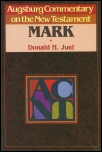
The Gospel of Mark is written from God’s perspective. The narrator knows how Scripture relates to events, what Jesus is thinking, what the disciples do or do not understand, and what the religious leaders suspect. He hears the voice from heaven addressed to Jesus alone; he knows about the conversation at Jesus’ trial where none of the disciples is present. The narrator, in other words, knows more than any of the characters could know. This is at least partly what Christians have meant in categorizing the books of the Bible as the inspired Word of God—the work claims an authority and truthfulness beyond ordinary texts.
In his commentary on the Gospel of Mark, Donald H. Juel provides a history of interpretation of the Gospel of Mark, the key issues in the Gospel, and exegetical and interpretive analysis.
Donald H. Juel is professor of New Testament at Luther Northwestern Theological Seminary. He has taught also at Indiana University and Princeton Theological Seminary. A popular lecturer to clergy and lay groups, he is the author of several books, among them Luke-Acts: The Premise of History and Messianic Exegesis: Christological Interpretation of the Old Testament in Early Christianity.
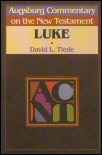
Luke’s story of Jesus is a straightforward narrative—it has a beginning, middle, and end. Both critics and non-critics may appreciate the profound simplicity of this story, perhaps even as they read it together. David L. Tiede’s commentary on Luke assists readers by enhancing and illuminating the significant themes and avoiding obscure and tangential topics which detract from meaningful interpretation. This commentary commends a reading of Luke’s story of Jesus by highlighting the narrative function of Luke’s Gospel and its literary characteristics, and helps reveal the truth to which Luke bears witness—the truth about God.
David L. Tiede has been a professor of New Testament at Luther Northwestern Theological Seminary since 1971 and became president of that institution in 1987. He is a graduate of St. Olaf College, Luther Theological Seminary, and Harvard University. He has also studied at Princeton Theological Seminary and taught at Scripps College and Claremont Graduate School. He has been a Rockefeller Fellow, a Danforth Fellow, Society of Biblical Literature Research Fellow at the Institute for Antiquity and Christianity, and a visiting professor of New Testament at Yale Divinity School. He served as pastor from 1972 to 1975, and participated in the Lutheran-Methodist dialogues in the United States and between the World Methodist Council and the Lutheran World Federation. He has served on various editorial councils and published several articles and books on Luke-Acts.
"John’s Gospel is the one, fine, true, and chief Gospel, and is far, far to be preferred over the other three and high above them." So wrote Martin Luther in one of the drafts of his Preface to the New Testament. Luther preferred John’s Gospel because it offered more of the words and fewer of the acts of Christ, and hence, for him at least, it was among the books which "show Christ and teach all that is necessary for you to know." His praise of the Gospel is justly deserved, for John’s Gospel presents the heart of the Christian message with clarity and force to reach contemporary readers. In this commentary on the Gospel of John, Robert Kysar outlines the literary, historical, and theological themes which illuminate John’s message for contemporary scholarship and modern readers.
Robert Kysar earned his Ph.D. in New Testament from Northwestern University, Evanston, Illinois, after an undergraduate education at the College of Idaho. He was a postdoctoral fellow in the Department of Religious Studies of Yale University, 1973–1974. After seventeen years of college teaching (of which twelve were spent at Hamline University, St. Paul, Minnesota), he became co-pastor of Christ United Lutheran Church, Gordon, Pennsylvania, with his wife, the Reverend Myrna C. Kysar. He is now professor of Homiletics and New Testament at the Lutheran Theological Seminary at Philadelphia.
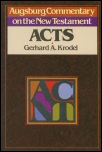
The book of Acts tells the story of the church’s most important juncture with history. In spite of rejections of the Messiah, God’s unconditional promises are in the process of realization in Luke’s account of salvation history. Luke’s story narrates and thereby interprets the fulfillment of conditional and unconditional promises in history and narrates the responses of believers and unbelievers. By interpreting the church’s course on its way from Jerusalem to Rome as the story of divine fulfillment, Luke gave encouragement and consolation in the face of perceived threats or real danger arising from conflicts with irate Jews, pagan neighbors, and Roman authorities.
The central importance of the book of Acts in the New Testament canon has made it the subject of much discussion, debate, and interpretation throughout the church’s history. In this volume, Gerhard A. Krodel outlines the history of interpretation of Acts and offers thoughtful and comprehensive commentary and exegesis for the entire book. This commentary includes a length introduction, an outline, a comprehensive bibliography, and reference maps.
Krodel has already written a commentary on Acts for the Proclamation Commentaries, but this one is much more substantial. Since the Augsburg Commentary on the New Testament series is written for “laypeople, students, and pastors,” Krodel gives little attention here to technical matters, other scholarship, or alternative interpretations. He alternates between exposition of Luke’s message, into which he weaves the (boldfaced) words of the passage (following the RSV), and historical-critical analysis of the text, occasionally adding homiletical comments. The result is, as commentaries go, refreshingly readable.
—Journal of the Evangelical Theological Society
Dr. Gerhard Krodel has been dean of Gettysburg Seminary and professor of New Testament since 1977. His professional education took place at the Universities of Erlangen and Tübingen. He also attended Concordia Seminary, St. Louis and took courses at Union Theological Seminary, New York. He served as pastor, taught classical languages at Capital University, and was professor of New Testament at Wartburg Theological Seminary and at the Lutheran Theological Seminary at Philadelphia. He has served on the Commission on Faith and Order of the National Council of Churches and on its Executive Committee, on the Task Force on Theology of the New Lutheran Church, and, since 1978, on the International Orthodox-Lutheran Dialog. He is the editor of Proclamation Commentaries.
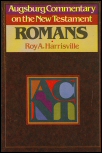
At every significant juncture in the life of Christian community the letter to the Romans has stood, and for every giant of faith ever raised up to effect some change in that community, it has furnished the fire. The book of Romans figured prominently in the conversion of Augustine, and its themes were central to the efforts of the Reformers. John Wesley found his heart “strangely warmed” at the reading of Luther’s preface to the epistle, and Karl Barth began to understand God amid the ravages of two World Wars while reading Romans. In this volume, Roy A. Harrisville helps illuminate the central themes of Romans and a history of its interpretation. This commentary also includes an introduction to the interpretation of Romans, a detailed outline of the entire epistle, a chapter-by-chapter commentary, and a lengthy bibliography.
Roy A. Harrisville is a graduate of Concordia College and Luther Theological Seminary. He was ordained in 1949 and served parishes in Minneapolis and Mason City, Iowa. In 1953 he received his Th.D. from Princeton Theological Seminary. Since 1958 he has been professor of New Testament at Luther-Northwestern Seminaries in St. Paul. He has done post-doctoral work at Tübingen and at other leading theological centers in Europe and America. A gifted speaker and teacher, he is in popular demand to lecture at churches and conferences. He has published numerous books and articles, and has translated significant theological works from German and French.
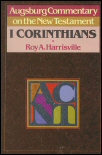
The congregation in Corinth consisted primarily of Gentile Christians who had converted through previous interaction with Paul, yet they profoundly misapplied Christian teachings in general and Paul’s instructions in particular. The Corinthian church faced mounting challenges: divisions and factions, sexual immorality, participation in pagan rituals, controversies over the Lord’s Supper, and speaking in tongues, along with the recurring threat of Gnosticism. Paul’s words of advice, encouragement, and reproach for the church in Corinth remain fitting and useful for contemporary challenges in the church, and Harrisville’s commentary on 1 Corinthians brings Paul’s words to the fore.
Roy A. Harrisville is a graduate of Concordia College and Luther Theological Seminary. He was ordained in 1949 and served parishes in Minneapolis and Mason City, Iowa. In 1953 he received his Th.D. from Princeton Theological Seminary. Since 1958 he has been professor of New Testament at Luther-Northwestern Seminaries in St. Paul. He has done post-doctoral work at Tübingen and at other leading theological centers in Europe and America. A gifted speaker and teacher, he is in popular demand to lecture at churches and conferences. He has published numerous books and articles, and has translated significant theological works from German and French.
Few pieces of correspondence by Paul have attracted so much controversial comment as has 2 Corinthians. Why does Paul seem oblivious to important historical events and theological themes relevant to the church in Corinth? How do the lost letters to the church in Corinth impact the interpretation and exegesis of 2 Corinthians? What cultural environment informed the significant themes of Paul’s epistle?
This commentary on 2 Corinthians addresses the significant historical, theological, and interpretive issues of 2 Corinthians. Frederick W. Danker explores the thrust of Paul’s message to the church in Corinth in this chapter-by-chapter commentary. This volume also includes a complete outline and comprehensive bibliography.
This evangelical work ranks high among those conversant with scholarly study regarding the setting of that day and offering a great deal of information.
—Master's Seminary Journal
Frederick W. Danker, professor emeritus of the Lutheran School of Theology at Chicago, is an ordained minister of the Evangelical Lutheran Church in America. He received his Ph.D. from the University of Chicago. Besides holding pastorates in various parishes, he served as instructor of New Testament for thirty-four years until his retirement in 1988.
His numerous writings range from lexicons, books, and articles in learned journals to publications in newspapers and popular magazines. Because of his ability to bridge academic and general interests, Danker is in frequent demand as a public lecturer on such varied topics as the politics of the Scriptures, proclamation based on the three series of the church year, and Jewish-Christian relations.
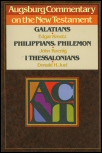
This volume of the Augsburg Commentary on the New Testament contains commentaries on Galatians, Philippians, Philemon, and 1 Thessalonians.
Galatians was written in the heat of controversy. Paul believed the Gospel to be under a deadly attack that would destroy the churches he had founded and ultimately destroy the Gospel itself. He used all the arguments at his command to counteract that attack: personal experience, biblical interpretation of the Old Testament, sarcasm, personal appeal, and the apostolic tradition. In this chapter-by-chapter commentary on Galatians, Edgar Krentz reveals the urgency and importance of Paul’s message and explains the relationship between the Galatian church and modern pastoral concerns.
Philippians, unlike Galatians, portrays a congregation in harmony with the teachings of Jesus and the writings of Paul. While Paul’s letter to the Galatians is filled with polemics, statements of self-defense, and attempts to correct misunderstandings about his teachings, Philippians contains no hint of emotional, intellectual, or spiritual conflict. The church in Philippi could make the legitimate claim to being Paul’s favorite. But this doesn’t mean the Philippian church was without problems. This commentary contains exegesis and interpretation of the key sections of Paul’s letter to the Philippians, and reveals a deep and honest relationship between Paul and the church in Philippi.
The short book of Philemon contains vexing cultural questions and reveals a tense relationship between slaves and masters. The epistle to Philemon remains part of the long tradition of Judeo-Christian attempts to achieve justice. This commentary bears out the accuracy of that vision.
Paul’s first letter to the Thessalonians is not classified as one of his major epistles. In this relatively brief letter Paul attacked no heresies, and more than half the letter is devoted to thanksgiving, allowing Paul the opportunity to express his concern and appreciate to God for the new congregation in Macedonia. Yet this letter to the Thessalonians is important because it offers a glimpse into a side of Paul’s ministry easily missed in his major letters. This chapter-by-chapter commentary portrays Paul as a pastor deeply concerned for his parishioners and thankful for the Gospel.
Edgar Krentz earned his M.Div. from Concordia Seminary, St. Louis, and the Ph.D. in classical philology from Washington University. He has taught New Testament at Concordia Theological Seminary and at Christ Seminary-Seminex in St. Louis.
John Koenig received his B.D. from Concordia Seminary, St. Louis, and his Th.D. from Union Seminary in New York. He is an ordained minister of the Lutheran Church in America.
Donald H. Juel is professor of New Testament at Luther Northwestern Theological Seminary. He has also taught at Indiana University and Princeton Theological Seminary.
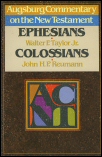
It is hard to touch anything in Ephesians without encountering—or creating—a problem. The book of Ephesians has touched off a firestorm of controversy in biblical scholarship—authorship, audience, date, theological emphases, and the like. Walter F. Taylor’s commentary on Ephesians brings order out of the Ephesian chaos.
Paul’s letter to the Colossians, however, presents another set of exegetical and interpretive challenges. In a time like ours when syncretistic versions of Christianity beckon alluringly, Colossians has an especially pertinent message. What are its theological emphases and its patterns of thought? In his commentary on Colossians, John H.P. Reumann shows the literary prominence of Christ and his ministry in the words of Paul’s letter.
Walter F. Taylor is Associate Professor of New Testament at Trinity Lutheran Seminary in Columbus, Ohio. A native of Omaha, Nebraska, he is a graduate of Midland Lutheran College, the Lutheran Theological Seminary at Philadelphia, and Claremont Graduate School. He also studied at Yale Divinity School. From 1973 to 1976 he was Instructor in Greek at the School of Theology at Claremont; from 1978 to 1981 he was Associate Pastor at First Lutheran Church, Lincoln, Nebraska. Dr. Taylor edits the Trinity Seminary Review and is a frequent speaker on Paul, Mark, and evangelism.
John H.P. Reumann is a graduate of Muhlenberg College and the Lutheran Theological Seminary at Philadelphia. Ordained in 1950, he has organized mission congregations in New Jersey and Pennsylvania and has taught at the Philadelphia Seminary for more than thirty years, where he has also served as Dean and Acting President. He has done postdoctoral study at Cambridge and Göttingen Universities and taught in India and Israel. As editor, author, lecturer, and preacher, he is widely known, especially in ecumenical circles, including Catholic dialog, and for his work in the “Word and Witness” program.
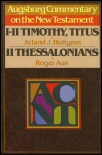
1 Timothy, 2 Timothy, and Titus are traditionally called the Pastoral Epistles, due to their aims and contents: they provide instructions for pastoral oversight of congregations, giving considerable attention to the qualifications and duties of congregational leaders who function as pastors. Some commentators have judged these epistles harshly, claiming that they reflect a version of Christianity concerned with organization and structure. These letters are said to lack the earlier zeal for the Gospel, the freedom of life in the Spirit, and the sense of the church as the dynamic people of God in pilgrimage.
As Arland J. Hultgren shows, the Pastoral Epistles are the work of a faithful witness to the Gospel, setting forth a synthesis of Christian doctrine and moral teaching. They keep the church faithful to its calling under the lordship of Christ, and serve as primary documents for studies in the doctrine of the church and its ministry.
The book of 2 Thessalonians, containing only three chapters, is the shortest in the New Testament with the exception of Philemon. Yet because of its subject matter, is remains one of the most interesting, and has enjoyed an extensive, influential, and even controversial history of interpretation. In 2 Thessalonians, Paul encourages the persecuted, warns against idleness, and describes the Day of the Lord. Roger Aus’s commentary on 2 Thessalonians contains an outline, bibliography, and chapter-by-chapter exegetical and interpretive analysis of the entire epistle.
Arland J. Hultgren is a graduate of the Lutheran School of Theology at Chicago. His Th.D. in New Testament is from Union Theological Seminary in New York. Since 1977 he has been a professor of New Testament at Luther Northwestern Theological Seminary.
Roger David Aus studied at St. Olaf College, Harvard Divinity School, Luther Theological Seminary, and Yale University, from which he received his Ph.D. in 1971. An ordained Lutheran clergyman, he has since served a German-speaking congregation in West Berlin, Germany, which granted him a study leave in Jerusalem, Israel in 1981.
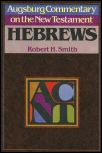
The book of Hebrews is not an epistle, not by Paul or any other eyewitness, and not addressed to a specifically Hebrew audience. In that case, what can be said positively about the author, the form, the genre, the time of composition, or the situation of the readers?
In this commentary, Robert H. Smith confronts the exegetical challenges posed by Hebrews. He offers a lengthy introduction to the authorship and historical situation of the book of Hebrews, and his chapter-by-chapter commentary and detailed outline offer interpretive and historical clues about the origins, purpose, and function of the book. In the end, Smith shows that the core themes of the book of Hebrews—the mediation of Christ and faith of believers—transcend geographical and temporal fixation.
Robert H. Smith earned the degree of Doctor of Theology at Concordia Theological Seminary in St. Louis. In 1968 he began to teach New Testament in seminaries, first at Concordia Seminary and at Seminex in St. Louis, and now as Christ Seminary-Seminex Professor of New Testament at Pacific Lutheran Theological Seminary in Berkeley, California.
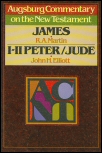
James has had a stormy and uncertain history in the Christian church. It had a difficult time getting into the New Testament, achieving canonical status in the Greek Church in the fourth century, the Latin Church in the fifth century, and the Syrian Church in the eighth century. Martin Luther famously judged James “an epistle of straw” and did not think it apostolic.
R. A. Martin’s commentary on James reveals the similarities and difference between James and other New Testament epistles and explains the historical and interpretive controversy behind the book. Most importantly, Martin finds canonical significance in a book almost solely devoted to loosely-connected moral and ethical admonitions and instructions.
For Christians throughout the ages the letter of 1 Peter has represented one of the highlights of New Testament proclamation. In his first translation of the original biblical texts into the common language of the German people, Martin Luther ranked 1 Peter among “the true and noblest books of the New Testament.” The high estimate of 1 Peter, however, has given way in modern biblical scholarship to debate over literary form, historical situation, authorship, affinities with other New Testament writings, and the nature and strategy of its theological and social message. John H. Elliott’s commentary offers an insightful approach to the key themes in 1 Peter.
In contrast to 1 Peter, 2 Peter has been met since the beginning with relatively strong resistance. Perhaps no book was received into the New Testament canon with greater hesitation, and its theological significance remained dubious. Yet the significance of 2 Peter lies in its witness to the attempt of the early church to remain true to its theological heritage amid a fragmented and skeptical culture. This commentary includes a lengthy introduction which surveys the history of interpretation, along with a detailed outline and chapter-by-chapter commentary.
Like 2 Peter, Jude’s inclusion in the canon testifies to the great importance the church once attached—and should continue to attach—to this letter’s concern for moral conduct and doctrinal orthodoxy. According to Jude, Christian behavior, no less than Christian belief, is a hallmark of the “faith once for all delivered to the saints.” Elliott’s commentary on Jude shows how this short letter preserves for Christianity the ethical heritage of Judaism and the indispensability of a faith active in love.
R. A. Martin is a graduate of Wartburg Seminary, Dubuque, Iowa. His Th.D. in biblical studies is from Princeton. Martin served as a missionary and professor in India from 1957 to 1969, when he became professor of biblical studies at Wartburg Seminary.
John H. Elliott is a graduate of Concordia Seminary, St. Louis. His Th.D. in New Testament is from the University of Münster, West Germany. Since 1968 he has been professor of theology at the University of San Francisco. Two books, The Elect and the Holy and A Home for the Homeless have established his reputation as a leading authority on 1 Peter.

No other document of the New Testament speaks more often and more explicitly of love than the epistles of John, and for that reason alone these books have become dear to the hearts of many Christians. 1, 2, & 3 John present us with expressions of the life of the earliest church in the struggle for unity and integrity, and for this reason these epistles merit study. Kysar’s commentary on the epistles of John offers exegetical analysis and comprehensive discussions of historical, theological, and interpretive challenges found in 1, 2, & 3 John.
Kysar needs no introduction to those who work in the field of Johannine studies. In addition to numerous essays and minor works, his major survey and assessment of these studies, The Fourth Evangelist and His Gospel, has rightly earned him gratitude and respect.
—Journal of the Evangelical Theological Society
Robert Kysar earned his Ph.D. in New Testament from Northwestern University, Evanston, Illinois, after an undergraduate education at the College of Idaho. He was a postdoctoral fellow in the Department of Religious Studies of Yale University, 1973–1974. After seventeen years of college teaching (of which twelve were spent at Hamline University, St. Paul, Minnesota), he became co-pastor of Christ United Lutheran Church, Gordon, Pennsylvania, with his wife, the Reverend Myrna C. Kysar. He is now professor of Homiletics and New Testament at the Lutheran Theological Seminary at Philadelphia.
Among his several books are Called to Care and four books on the Gospel of John. He is a member of the Society of Biblical Literature and the Society for New Testament Studies.

Perhaps no book in the entire New Testament has been misinterpreted to the extent of Revelation. The imagery and symbolism—and the entire genre of apocalyptic literature—presents an obstacle to interpretation, and exegetical method must be applied carefully. Gerhard Krodel, in his commentary on Revelation, offers a lengthy synopsis of Revelation’s interpretive history, including the myriad ways Revelation is misinterpreted. Yet a careful reading of Revelation reveals the nature of apocalyptic literature and the creative ways in which God speaks.
…an excellent commentary…for pastors, preachers, and students…It is scholarly without being over-academic and it is readable.
—Online reviewer
Dr. Gerhard Krodel has been dean of Gettysburg Seminary and professor of New Testament since 1977. His professional education took place at the Universities of Erlangen and Tübingen. He also attended Concordia Seminary, St. Louis and took courses at Union Theological Seminary, New York. He served as pastor, taught classical languages at Capital University, and was professor of New Testament at Wartburg Theological Seminary and at the Lutheran Theological Seminary at Philadelphia. He has served on the Commission on Faith and Order of the National Council of Churches and on its Executive Committee, on the Task Force on Theology of the New Lutheran Church, and, since 1978, on the International Orthodox-Lutheran Dialog. He is the editor of Proclamation Commentaries.
Reviews
4 ratings

Ralph A. Abernethy III
9/7/2017
Calvin L. Coles
4/17/2015

tascia
10/6/2014
Jacob G.
8/29/2013
